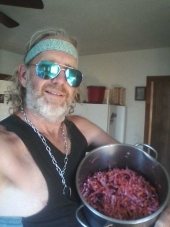




Kevin EarthSoul (real, legal name)
Omaha, NE
 1
1




I got my batch started by adding whey off the top of some Greek Yogurt as well as some pickle juice to my water. I didn't salt it heavily. I'm wondering how long I should let it ferment at room temp.
"We're all just walking each other home." -Ram Dass
"Be a lamp, or a lifeboat, or a ladder."-Rumi
"It's all one song!" -Neil Young




Kevin EarthSoul (real, legal name)
Omaha, NE




"We're all just walking each other home." -Ram Dass
"Be a lamp, or a lifeboat, or a ladder."-Rumi
"It's all one song!" -Neil Young
 2
2




Kevin EarthSoul (real, legal name)
Omaha, NE
 1
1










Ask me about food.
How Permies.com Works (lots of useful links)





![Filename: image.jpg
Description: Fermentation jar [Thumbnail for image.jpg]](/t/44754/a/32484/image.jpg)
Thanks







 1
1




Ask me about food.
How Permies.com Works (lots of useful links)
















Ask me about food.
How Permies.com Works (lots of useful links)

 1
1




Check out Redhawk's soil series: https://permies.com/wiki/redhawk-soil
 1
1




... it´s about time to get a signature ...




... it´s about time to get a signature ...











Ask me about food.
How Permies.com Works (lots of useful links)






www.ultimatepicklejar.com




Julia Winter wrote:Carbon dioxide, I believe. Non-toxic, I'm sure.
... it´s about time to get a signature ...




www.ultimatepicklejar.com




Check out Redhawk's soil series: https://permies.com/wiki/redhawk-soil







 1
1




Ask me about food.
How Permies.com Works (lots of useful links)





Check out Redhawk's soil series: https://permies.com/wiki/redhawk-soil




... it´s about time to get a signature ...




www.ultimatepicklejar.com

|
See where your hand is? Not there. It's next to this tiny ad:
Learn Permaculture through a little hard work
https://wheaton-labs.com/bootcamp
|





